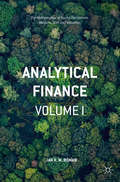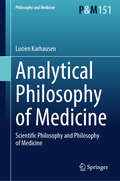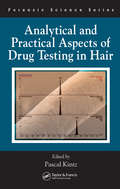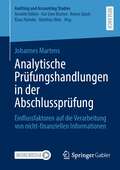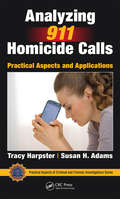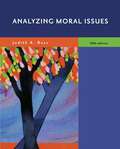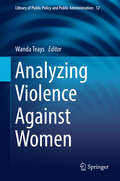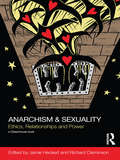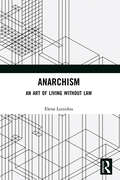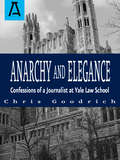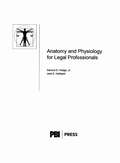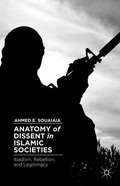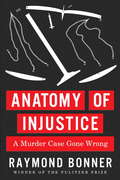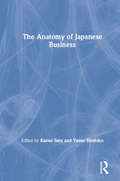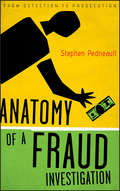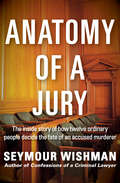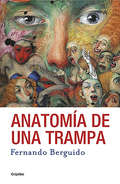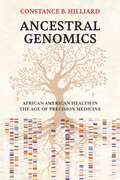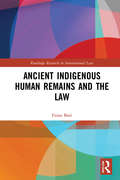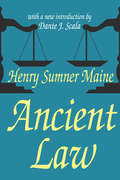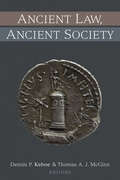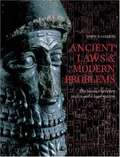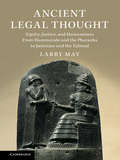- Table View
- List View
Analytical Finance: The Mathematics of Equity Derivatives, Markets, Risk and Valuation
by Jan R. M. RömanThis book provides an introduction to the valuation of financial instruments on equity markets. Written from the perspective of trading, risk management and quantitative research functions and written by a practitioner with many years' experience in markets and in academia, it provides a valuable learning tool for students and new entrants to these markets. Coverage includes: #65533;Trading and sources of risk, including credit and counterparty risk, market and model risks, settlement and Herstatt risks. #65533;Numerical methods including discrete-time methods, finite different methods, binomial models and Monte Carlo simulations. #65533;Probability theory and stochastic processes from the financial modeling perspective, including probability spaces, sigma algebras, measures and filtrations. #65533;Continuous time models such as Black-Scholes-Merton; Delta-hedging and Delta-Gamma-hedging; general diffusion models and how to solve Partial Differential Equation using the Feynmann-Kac representation. #65533;The trading, structuring and hedging several kinds of exotic options, including: Binary/Digital options; Barrier options; Lookbacks; Asian options; Chooses; Forward options; Ratchets; Compounded options; Basket options; Exchange and Currency-linked options; Pay later options and Quantos. #65533;A detailed explanation of how to construct synthetic instruments and strategies for different market conditions, discussing more than 30 different option strategies. With source code for many of the models featured in the book provided and extensive examples and illustrations throughout, this book provides a comprehensive introduction to this topic and will prove an invaluable learning tool and reference for anyone studying or working in this field.
Analytical Philosophy of Medicine: Scientific Philosophy and Philosophy of Medicine (Philosophy and Medicine #151)
by Lucien KarhausenThis book describes the philosophy of medicine as a subset of the philosophy of science. It is grounded in an epistemological bottom-up account that arises from the clinical situation, the epidemiologic and the resulting public health account. The volume offers a set of coherent beliefs that are deductively closed, which means that any statement which is logically entailed by the theory belongs to the theory. Medicine does not originate, as usually admitted, with the notion of disease inasmuch as concepts of disease, malfunction or health are evolved, sophisticated and advanced constructs. Medical norms, i.e., pathological features, are logically and conceptually prior to normal features. Following Ludwig Wittgenstein, by analogy with the way members of a family resemble each other, diseases are often what Ludwig Wittgenstein called “family-resemblance concepts”, which manifest a similarity shared by things classified into certain groups in the way members of a family resemble each other: each shares characteristics which many but not all the others, and there are no necessary or sufficient conditions for belonging in that classification. This book analyses the confusions associated with the concept of health, and subsequently turns to medical interventions, preventive, therapeutic and palliative as well as to the caring relationship, patients’ autonomy, doctors’ authority, and paternalism. Finally, the epistemic, ethical, or ontological limits of medicine, are being discussed, and the final account leaves us at the end of the scale with the perspective afforded by the patient facing suffering, impairment, death and tragedy, not to mention the physician’s predicament, which give rise to the principle that undergirds them all, i.e., the value of life.
Analytical and Practical Aspects of Drug Testing in Hair (International Forensic Science and Investigation)
by Pascal KintzWritten by well-known, international authors, this comprehensive reference provides practical coverage of the best hair drug testing techniques and examines the drugs themselves. The authors review all new developments, the validation of analytical procedures, and the interpretation of data. Some of the applications discussed include doping, drug-facilitated crime investigating, workplace testing, and the granting of drivers' licenses. The authors describe specific drugs, such as opiates, cocaine, and cannabis, and discuss the different testing methods of them. The book also covers postmortem toxicology, pitfalls created by passive exposure, and testing for metals, including inductively coupled plasma spectrometry (ICP-MS), hair multielemen
Analytische Prüfungshandlungen in der Abschlussprüfung: Einflussfaktoren auf die Verarbeitung von nicht-finanziellen Informationen (Auditing and Accounting Studies)
by Johannes MartensIn der Abschlussprüfung werden neben Informationen aus der traditionellen Analyse von finanziellen Daten zunehmend Informationen aus der Analyse von nicht-finanziellen Daten berücksichtigt. Die Nutzung von nicht-finanziellen Informationen ist hierbei kein neues Phänomen, jedoch ermöglichen jüngere datenanalytische Verfahren, wie z. B. Text-Data-Mining, die Auswertung bisher wenig beachteter, unkonventioneller Datenquellen, die zunehmend in die prüferische Urteilsfindung Eingang finden. In diesem Zusammenhang wird in dieser Arbeit aus einer verhaltenswissenschaftlichen Perspektive untersucht, welche Bedeutung nicht-finanzielle Informationen aus der Analyse von Wetter-, Strom- und Internetdaten zur Plausibilisierung der Umsatzerlöse im Rahmen einer analytischen Prüfungshandlung für Prüfer besitzen. Hierfür wird eine experimentelle Untersuchung mit Prüfern durchgeführt, die drei wesentliche Faktoren bei der Verarbeitung der nicht-finanziellen Informationen fokussiert: das Bedürfnis nach kognitiver Geschlossenheit, die Informationskonsistenz und der fraud-Risiko-Kontext. Die Ergebnisse deuten unter anderem auf einen Einfluss des Bedürfnisses nach kognitiver Geschlossenheit und der Informationskonsistenz hin. Die Befunde liefern interessante Einsichten für Prüfungspraxis und -forschung.
Analyzing 911 Homicide Calls: Practical Aspects and Applications (Practical Aspects of Criminal and Forensic Investigations)
by Tracy Harpster Susan H. AdamsThis book provides police investigators and homicide detectives with a practical method of analyzing 911 homicide calls to uncover the truth. A structured analysis of 911 homicide calls can directly aid in developing investigative leads, planning interviews and solving cases. Case examples present proven, reliable methods as to when a caller is telling the truth or not. This book lays out a framework to analyze the call to determine truth from fiction. Every member of the investigative team, from call-taker to first responder, investigator, coroner’s investigators, and prosecutor, can contribute to the success of investigations through their knowledge of 911 call analysis.
Analyzing Moral Issues (5th edition)
by Judith A. BossThis text with readings addresses a variety of timely and interesting moral issues, providing background information and primary source selections for each issue presented. It includes a chapter on ethical theory and covers a broad range of ethical perspectives--among them virtue ethics (Aristotelian and Confucian), Buddhist and feminist care ethics, and the Rawlsian and communitarian approaches. The fifth edition also includes new readings and case studies covering some of the more pressing issues of recent ethical debate, such as genetic enhancement of children, racism and sexism in the 2008 presidential elections, the effect of the U. S. Patriot Act on academic freedom, military conscription, and global warming.
Analyzing Violence Against Women (Library of Public Policy and Public Administration #12)
by Wanda TeaysThis timely anthology brings into sharp relief the extent of violence against women. Its range is global and far reaching in terms of the number of victims. There are deeply entrenched values that need to be rooted out and laid bare.This text offers a philosophical analysis of the problem, with important insights from the various contributors. Topics range from sexual assault to media violence, prostitution and pornography, domestic violence, and sexual harassment. Each of the four parts include essays which tackle these issues and provide us with tools for bringing about change.The philosophical approaches to the topic give readers insight into the harms of interpersonal violence and its impact on the lives of its victims. Analyzing Violence Against Women calls us to examine public policies and work for systemic change. In the process, we are reminded that the concerns of the discipline of Philosophy encompasses issues with a wider scope.Students will especially benefit from seeing how the various authors grapple with this pressing issue and clarify why we need to bring about change.
Anarchism & Sexuality: Ethics, Relationships and Power (Social Justice)
by Jamie Heckert Richard CleminsonAnarchism & Sexuality aims to bring the rich and diverse traditions of anarchist thought and practice into contact with contemporary questions about the politics and lived experience of sexuality. Both in style and in content, it is conceived as a book that aims to question, subvert and overflow authoritarian divisions between the personal and political; between sexual desires categorised as heterosexual or homosexual; between seemingly mutually exclusive activism and scholarship; between forms of expression such as poetry and prose; and between disciplinary categories of knowledge. Anarchism & Sexuality seeks to achieve this by suggesting connections between ethics, relationships and power, three themes that run throughout. The key objectives of the book are: to bring fresh anarchist perspectives to debates around sexuality; to make a queer and feminist intervention within the most recent wave of anarchist scholarship; and to make a queerly anarchist contribution to social justice literature, policy and practice. By mingling prose and poetry, theory and autobiography, it constitutes a gathering place to explore the interplay between sexual and social transformation.This book will be of use to those interested in anarchist movements, cultural studies, critical legal theory, gender studies, and queer and sexuality studies.
Anarchism: An Art of Living Without Law
by Elena LoizidouThe term anarchism derives from the Greek word ἀναρχία meaning ‘without ruler or leader, and without law’. Although the roots of the word can be traced back to Ancient Greece, anarchism as a political ideology is relatively new. Anarchism developed as a political ideology at the end of the eighteenth century at the time of the emergence of the modern State. And, as is well known, anarchism developed both a politics and a way of life that did not include the State as its compass, support and structure. In contrast to the extensive contemporary literature about anarchist politics and ideas, this book focuses on the practices and attitudes that constitute what the author refers to as an anarchist ‘art of life’. The book draws on archival material that records the life and actions of the anarchist Emma Goldman and her associates, legal documents and writings by classical (Pierre Joseph Proudhon, Peter Krotopkin) and contemporary anarchists (David Graeber, Saul Newman, Ciarra Bottici), as well as contemporary groups such as the Clandestine Insurgent Rebel Clown Army and Occupy Wall Street. By studying the idiosyncrasies of this art of life, it argues, we are better able to appreciate how anarchism is not some future utopian oriented project, waiting to come into existence after a revolution, but rather exists in parallel to the life and politics offered by the State. Anarchism: An Art of Living Without Law will be of interest to graduate students and academics working on critical legal theory, political theory, sociology and cultural studies.
Anarchy and Elegance: Confessions of a Journalist at Yale Law School
by Chris GoodrichIn Anarchy and Elegance Chris Goodrich deconstructs the inner workings of legal education at the nation's most prestigious law school. A former legal reporter, Goodrich - a Yale graduate - attended the law school on a year-long fellowship for journalists, and soon found himself in a mare's nest of conflicting ideas, emotions, and social visions. His class-by-class account, which showed exactly how law students learn to "think like lawyers," highlights the tension between the often-elegant abstractions of law and the messy, anarchic specifics of "real life." (Edmund Burke's alleged view: "Law sharpens the mind by narrowing it.") His initial skepticism about the law's tendency to operate in a self-referential, we-know-best manner is slowly tempered by admiration for its rigorous methods and theoretical good-faith, and results in a book that proves as entertaining as it is informative.Anarchy and Elegance has been called:"[T]he most creative book on law school in recent memory" (John Jay Osborne, author of The Paper Chase) "A perceptive and insightful inside look at one of America's most influential institutions" (Charles A. Reich, former Yale Law professor and author of The Greening of America) "[A] vivid, amusing and thought-provoking description of what it feels like on the [legal] battlefield" (Robert Heilbroner, author of The Wordly Philosophers)"[Essential, cautionary reading for budding lawyers" (Publishers Weekly)."[A] masterful contribution of the literature of reportage" (Magill Book Review)"[A] bull's eye" (The Jerusalem Post).
Anarchy and Legal Order
by Gary ChartierThis book elaborates and defends the idea of law without the state. Animated by a vision of peaceful, voluntary cooperation as a social ideal and building on a careful account of non-aggression, it features a clear explanation of why the state is illegitimate, dangerous, and unnecessary. It proposes an understanding of how law enforcement in a stateless society could be legitimate and what the optimal substance of law without the state might be, suggests ways in which a stateless legal order could foster the growth of a culture of freedom, and situates the project it elaborates in relation to leftist, anti-capitalist, and socialist traditions.
Anatomy And Physiology For Legal Professionals
by Samuel D. Hodge Jack E. HubbardFrom one of the most popular continuing legal education instructors in the country, known for the interactive teaching style of his anatomy for lawyers courses, author Sam Hodge and co-author Jack Hubbard, MD, have written this essential guide. Covering all the systems of the body, from the skeletal system to the immune system and its disorders, this book gives lawyers a clear understanding of every facet of human anatomy affecting their client's case. The book includes more than 275 medical illustrations and examples of cases dealing with medical issues.
Anatomy Of Dissent In Islamic Societies
by Ahmed E. SouaiaiaAnatomy of Dissent in Islam is an interdisciplinary study of political and legal dissent in Islamic civilization from the seventh century on. (7th century). Using Ibadism as a case study, this work explores the events and teachings that shaped legitimacy and rebellion, orthodoxy and sectarianism, and law and culture in Islamic societies.
Anatomy of Injustice: A Murder Case Gone Wrong
by Raymond BonnerThe book that helped free an innocent man who had spent twenty-seven years on death row. In January 1982, an elderly white widow was found brutally murdered in the small town of Greenwood, South Carolina. Police immediately arrested Edward Lee Elmore, a semiliterate, mentally retarded black man with no previous felony record. His only connection to the victim was having cleaned her gutters and windows, but barely ninety days after the victim’s body was found, he was tried, convicted, and sentenced to death. Elmore had been on death row for eleven years when a young attorney named Diana Holt first learned of his case. After attending the University of Texas School of Law, Holt was eager to help the disenfranchised and voiceless; she herself had been a childhood victim of abuse. It required little scrutiny for Holt to discern that Elmore’s case-plagued by incompetent court-appointed defense attorneys, a virulent prosecution, and both misplaced and contaminated evidence-reeked of injustice. It was the cause of a lifetime for the spirited, hardworking lawyer. Holt would spend more than a decade fighting on Elmore’s behalf. With the exemplary moral commitment and tenacious investigation that have distinguished his reporting career, Bonner follows Holt’s battle to save Elmore’s life and shows us how his case is a textbook example of what can go wrong in the American justice system. He reviews police work, evidence gathering, jury selection, work of court-appointed lawyers, latitude of judges, iniquities in the law, prison informants, and the appeals process. Throughout, the actions and motivations of both unlikely heroes and shameful villains in our justice system are vividly revealed. Moving, suspenseful, and enlightening,Anatomy of Injusticeis a vital contribution to our nation’s ongoing, increasingly important debate about inequality and the death penalty.
Anatomy of Japanese Business
by Kasuo SatoThis volume collects eleven essays written by Japanese experts on various aspects of Japanese business management and is a sequel to the volume Industry and Business in Japan. It examines the mechanisms for Japan 's phenomenal economic growth since the Second World War by analyzing Japanese management, business groups, production systems and business strategy.
Anatomy of a Fraud Investigation
by Stephen PedneaultA one-of-a-kind resource walking you through one complete fraud investigation, from the original tip to conviction in courtAnatomy of a Fraud Investigation is an engrossing read and a valuable resource for fraud investigators, auditors, or anyone who suspects fraud may be occuring in their organizations and is unsure as to how to act. It details all phases of a fraud investigation from the first suspicion of fraud to the final judgment in court, through the eyes of a forensic accountant. In each phase, the author provides insights based on his twenty-two years as a forensic accountant from where to sit at the table when you bring the suspected fraudster in for questioning, to how you protect the key sources of information that the suspect will try to destroy once he or she realizes they are under investigation. In-depth analysis of a fraud investigation Based on an actual investigation conducted by the author Each chapter contains valuable tips and key considerations, providing subtext for why decisions were made and bringing to light potential risks A fascinating, insider look at a fraud investigation, Anatomy of a Fraud Investigation helps you better understand fraud detection, investigation, and prevention-from the inside out.
Anatomy of a Jury: The Inside Story of How Twelve Ordinary People Decide the Fate of an Accused Murderer
by Seymour WishmanAn acclaimed trial attorney presents a mock murder case to explore the jury system in this &“compelling . . . intelligent . . . provocative&” work (The New York Times Book Review). Creating a composite legal case based on real-life criminal investigations and trials, Seymour Wishman&’s Anatomy of a Jury carries us from crime scene to courthouse to jury room, providing a fascinating, behind-the-scenes look into the nation&’s criminal justice system. In autumn 1982, in the affluent New Jersey community of Glen Ridge, a woman is found brutally murdered in her home. The victim&’s distraught husband points police to a likely perpetrator: an African American handyman with a criminal record. A search of the suspect&’s home reveals nothing, but still the man is indicted for the crime. His ultimate fate is to be determined by &“a jury of his peers&”—twelve strangers with no special legal skills or training and a fervent desire to do what is right. As dramatic and riveting as it is educational, Wishman&’s staging and analysis of a criminal trial is a &“rousing endorsement of the jury and a superb description of how the system really operates&” (St. Louis Dispatch).
Anatomía de una trampa
by Fernando BerguidoUna historia verídica de codicia y afán por el poder, con pasajes que parecen tomados de la mejor ficción. En 2009, Ricardo Martinelli fue elegido presidente de Panamá. Su primer viaje oficial fue a Italia porque quería conocer a un personaje que admiraba: Silvio Berlusconi. Ambos eran empresarios multimillonarios, convertidos en políticos, mesiánicos y narcisistas que, una vez en el poder, siguieron haciendo negocios. Ganaron con base a plataformas antisistemas, atacando a los políticos tradicionales en un neopopulismo encabezado por personajes espontáneos y coloridos, en los que prevalecía la improvisación, los eslóganes, la superficialidad y vidas personales rodeadas de excesos. El encuentro terminó con la firma de contratos millonarios por los que salió a la luz la existencia de unas extrañas comisiones cuyo destino se descubre en esta historia. El libro narra la historia desde el primer encuentro entre ambos mandatarios, el rol de los distintos personajes, viajes clandestinos, grabaciones de llamadas, amenazas a periodistas, difusión de falsas noticias, hasta el proceso de investigación llevado a cabo tanto por periodistas de ambos países como por un par de fiscales italianos quienes, con sus pesquisas, sorprendieron a los tramposos. Fernando Berguido estuvo involucrado en las primeras investigaciones periodísticas que denunciaron los contratos, siguió la saga que duró más de cinco años y terminó siendo embajador de Panamá en Italia, teniendo a su cargo las negociaciones que finalizaron con la anulación de los contratos y la devolución de los sobreprecios. El autor no repara en mencionar con nombres y apellidos a personajes de la vida política panameña, muchos de ellos aún en puestos importantes de la administración. Otros siguen prófugos.
Ancestral Genomics: African American Health in the Age of Precision Medicine
by Constance B. HilliardA leading evolutionary historian offers a radical solution to racial health disparities in the United States.Constance B. Hilliard was living in Japan when she began experiencing joint pain. Her doctor diagnosed osteoarthritis—a common ailment for someone her age. But her bloodwork showed something else: Hilliard, who had never had kidney problems, appeared to be suffering from renal failure. When she returned to Texas, however, a new round of tests showed that her kidneys were healthy. Unlike the Japanese doctor, her American primary care provider had checked a box on her lab report for “African American.” As a scholar of scientific racism, Hilliard was perplexed. Why should race, which experts agree has no biological basis, matter for getting accurate test results?Ancestral Genomics is the result of Hilliard’s decade-long quest to solve this puzzle. In a masterful synthesis of evolutionary history, population genetics, and public health research, she addresses the usefulness of race as a heuristic in genomic medicine. Built from European genetic data, the Human Genome Project and other databases have proven inadequate for identifying disease-causing gene variants in patients of African descent. Such databases, Hilliard argues, overlook crucial information about the environments to which their ancestors’ bodies adapted prior to the transatlantic slave trade. Hilliard shows how, by analyzing “ecological niche populations,” a classification model that combines family and ecological histories with genetic information, our increasingly advanced genomic technologies, including personalized medicine, can serve African Americans and other people of color, while avoiding racial essentialism.Forcefully argued and morally urgent, Ancestral Genomics is a clarion call for the US medical community to embrace our multigenomic society.
Ancient Greece
by Robert PayneA history of Greece from its founding to the advent of Philip of Macedon. Covers all aspects of Greek life, philosophy and literature.
Ancient Indigenous Human Remains and the Law (Routledge Research in International Law)
by Fiona BattIndigenous peoples are increasingly making requests for the return of their ancestors’ human remains and ancient indigenous deoxyribonucleic acid. However, some museums and scientists have refused to repatriate indigenous human remains or have initiated protracted delays. There are successful examples of the return of ancient indigenous human remains however the focus of this book is an examination of the "hard" cases. The continued retention perpetuates cultural harm and is a continuing violation of the rights of indigenous peoples. Therefore this book develops a litigation Toolkit which can be used in such disputes and includes legal and quasi legal instruments from the following frameworks, cultural property, cultural heritage, cultural rights, collective heritage, intellectual property, Traditional Knowledge and human rights. The book draws on a process of recharacterisation. Recharacterisation is to be understood to mean the allocation of an indigenous peoples understanding and character of ancient indigenous human remains and ancient indigenous DNA, in order to counter the property narrative articulated by museums and scientists in disputes.
Ancient Law
by Dante J. Scala Sir Henry MaineBest known as a history of progress, Ancient Law is the enduring work of the 19th-century legal historian Henry Sumner Maine. Even those who have never read Ancient Law may find Maine's famous phrase "from status to contract" familiar. His narrative spans the ancient world, in which individuals were tightly bound by status to traditional groups, and the modern one, in which individuals are viewed as autonomous beings, free to make contracts and form associations with whomever they choose. Maine's dichotomy between status-based societies and contract-based societies is a variation on a theme that has absorbed the social sciences for a century: the distinction between Gemeinschaft (community) and Gesellschaft (society). This theme has been elaborated upon by such eminent scholars as Tonnies, Durkheim, Weber, Simmel, and Parsons. Along with many lesser scholars, they have considered what we gained and what we lost when we left behind a social world held together by communal, primordial bonds, and adopted one based upon impersonal temporary agreements among individuals. Maine wrote Ancient Law to increase knowledge about the internal mechanics of developing societies. He felt a key objective was better understanding of how law develops over time. Failure to understand temporal processes in relation to legal development, he argues, leads to the creation of false dichotomies. The most important of these is the alleged division between the ancient and the modern, which Maine described as an "imaginary barrier" at which modern scholars feel they must stop and go no further. Maine's desire to breach this barrier led him to present this complex and richly nuanced analysis of legal evolution. This book will be of interest to historians, political philosophers, and those interested in the development of law.
Ancient Law, Ancient Society
by Dennis P. Kehoe Thomas McginnThe essays composing Ancient Law, Ancient Society examine the law in classical antiquity both as a product of the society in which it developed and as one of the most important forces shaping that society. Contributors to this volume consider the law via innovative methodological approaches and theoretical perspectives—in particular, those drawn from the new institutional economics and the intersection of law and economics. Essays cover topics such as using collective sanctions to enforce legal norms; the Greek elite’s marriage strategies for amassing financial resources essential for a public career; defenses against murder charges under Athenian criminal law, particularly in cases where the victim put his own life in peril; the interplay between Roman law and provincial institutions in regulating water rights; the Severan-age Greek author Aelian’s notions of justice and their influence on late-classical Roman jurisprudence; Roman jurists’ approach to the contract of mandate in balancing the changing needs of society against respect for upper-class concepts of duty and reciprocity; whether the Roman legal authorities developed the law exclusively to serve the Roman elite’s interests or to meet the needs of the Roman Empire’s broader population as well; and an analysis of the Senatus Consultum Claudianum in the Code of Justinian demonstrating how the late Roman government adapted classical law to address marriage between free women and men classified as coloni bound to their land. In addition to volume editors Dennis P. Kehoe and Thomas A. J. McGinn, contributors include Adriaan Lanni, Michael Leese, David Phillips, Cynthia Bannon, Lauren Caldwell, Charles Pazdernik, and Clifford Ando.
Ancient Laws and Modern Problems: The Balance Between Justice and a Legal System
by John SassoonThe author’s study of the written laws of four thousand years ago puts paid to the belief that the most ancient laws were merely arbitrary and tyrannical. On the contrary, the earliest legal systems honestly tried to get to the truth, do justice to individuals, and preserve civil order. They used the death penalty surprisingly seldom, and then more because society had been threatened than an individual killed. Some of the surviving law codes are originals, others near-contemporary copies. Together they preserve a partial but vivid picture of life in the early cites. This occupies more than half the book. Comparison of ancient with modern principles occupies the remainder and is bound to be controversial; but it is important as well as fascinating. The first act of writing laws diminished the discretion of the judges and foretold a limit on individual justice. Some political principles such as uniformity of treatment or individual freedom have, when carried to extremes, produced crises in modern legal systems world wide. But it is tempting but wrong to blame the judges or the lawyers for doing what society require of them.
Ancient Legal Thought: Equity, Justice, and Humaneness From Hammurabi and the Pharaohs to Justinian and the Talmud
by Larry MayThis is a study of what constituted legality and the role of law in ancient societies. Investigating and comparing legal codes and legal thinking of the ancient societies of Mesopotamia, Egypt, Greece, India, the Roman Republic, the Roman Empire and of the ancient Rabbis, this volume examines how people used law to create stable societies. Starting with Hammurabi's Code, this volume also analyzes the law of the pharaohs and the codes of the ancient rabbis and of the Roman Emperor Justinian. Focusing on the key concepts of justice equity and humaneness, the status of women and slaves, and the idea of criminality and of war and peace; no other book attempts to examine such diverse legal systems and legal thinking from the ancient world.
